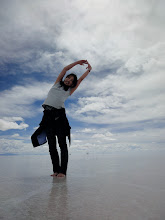


Hallelujah!
At one point, I didn't believe it was going to cantilever...When I saw it a couple of weeks ago, the parts lying around on the floor looked gigantic and ridiculously heavy. But now, I'm so glad I was involved with the engineering part of this installation.
先学期 Buro Happold で modeling や optimization を手伝っていた Dragonfly。アルミニウムのトンボの羽のモチーフです。組み立てにも参加する予定でしたが、日本に帰っている間に完成していました。こんなに重いものを空中で固定する のは建築家(デザイナー)の独断では無理です。Structure Engineer とチームを組み、綿密な計算と調整を経てやっと実現します。
Thesis Notes
-Tom Wiscombe did not need to specify the width or thickness of each volonoi cell or the location of bolts. Type of connections were designed as project went. For this type of architecture project, as long as designers are familiar with some reliable engineering software, the “analysis and optimization” can be part of the design process (S.D. D.D. C.D. B.N. C.A.). Probably between Design Document and Construction Document.
-In a way, “analysis and optimization” phase is required for any design process. But I would like to deal specifically with parametric design (Digital Project, CATIA), for the sake of this phase to be architect's role instead of leaving it all up to structure engineers.
-“analysis and optimization” is for the sake of 1. aesthetic, 2. strength, 3. efficiency. In CATIA, 3D models are 1. easy to update (aesthetic), 2. specific to assigned material and interchangeable with major engineering software (strength), 3. under control of parameter (efficiency).
-Since difficulty in information management is the inevitable issue for large scale projects, the more, the scale of a project gets larger, architects and engineers can be benefit from Parametric softwares. But as I mentioned before, I'm interested in small scale projects that architects can be in charge of without organizing project team out of immense number of professionals.
-To test the accuracy of Engineering Software, test one of my Origami motifs but in different scale, material, and variations.
-Designers should stay away from challenging extreme geometry if it is only for the sake of commercial impact. (...social, historical argument to be established)
Case Study Predecessors
Dragonfly (Tom Wiscombe), Ribbon House (Peter Testa), Kanno Museum (Hitoshi Abe), Sendai Mediatech, Serpentine Pavilion (Toyo Ito), Floral Street Bridge (Wilkinson Eyre)
Use of parametric design: Floral Street Bridge (aesthetic), Dragonfly (strength), Kanno Museum (efficiency)

1 comment:
very very cool Yuki
Post a Comment